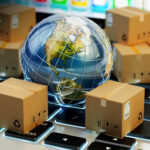More than a decade ago, when cosmetics company 100% Pure was starting to sell internationally, it ran a separate website for each country, which “was a lot of overhead,” according to founder and CEO Ric Kostick.
“It was a big deal when we finally combined the websites and figured out, we can have our U.K. customers, our European customers, our Canadian customers” all using the same storefront, Kostick said during a PYMNTS TV discussion.
Kostick noted that nowadays, many merchants have tech partners that automate cross-border selling on the back end, making it easier to sell beyond the domestic market.
“It isn’t without its challenges, but the customers want to come to your site wherever they are around the world, they want to order and have the same experience or a similar experience as your domestic customer,” Kostick said.
In a recent interview, Kostick, along with Digital River CEO Adam Coyle and Waterdrop founder and CEO Martin Murray, said that providing a unified customer experience in a borderless world is increasingly important.
Companies that don’t allow customers one-click access to their wares wherever they are risk losing out — and that means taking a hard look at everything from payment platforms and supply chains to brand perception and customer service.
Coyle said that consumers “are increasingly comfortable with the idea of buying things cross-border,” and as a result, their expectations are constantly “ratcheting” up.
“Consumers want to have the same experience in a cross-border transaction that they experience in a domestic transaction, and they bring the same set of expectations that they have for a local transaction into the cross-border sphere,” Coyle said.
Related news: Merchants Use Data, Payment Tech to Reduce Costs, Increase Online Global Sales
That means providing not only a delivery experience that consumers are familiar and comfortable with, such as a guarantee of delivery within a certain number of days, but also a payment experience that is “local and native to their region, their geography, their country.”
“A lot of the friction comes in from things like being able to have payment types that the local consumers understand,” Coyle said. “Not everybody has Visa and Mastercard.”
Murray said that matching payments to local preference is much easier than it was a few years go, thanks to the global spread of platforms like Shopify and payment providers, including PayPal and Apple Pay.
However, that doesn’t mean that brands want to become undomiciled — for 100% Pure, Kostick said it’s actually a selling point that the company is based in the U.S., because “customer perception of different countries is different in terms of where products are coming from in beauty.” For example, the U.S. and Europe are perceived as high-end, whereas China doesn’t have as a high of a reputation in that industry.
Murray said he would “actually love a Spaniard to think that we’re from Spain and Americans thinking we’re from the States” — but there’s also merit in saying that Waterdrop is based in Austria and produces products in Germany.
“A lot of people think localization is making my brand look like it’s from the U.S. or the U.K., and it’s really not about that,” Coyle said. “It’s basically being able to tell your German brand story to a U.S. customer in a way they can understand, and so that they appreciate the value of your brand.”
From Europe to the U.S.
Though the cost per thousand impressions (CPM) is “far more expensive” in the U.S. than it is in Europe, Murray said it’s “significantly easier” to sell on the western side of the Atlantic Ocean, “because you just have one big, beautiful market.”
“If you make it in Europe, it’s quite easy to scale in the States because Europe is really painful,” Murray said. “You have like 30 small countries with different languages, with different VAT [value-added tax] schemes, which you have to adhere to in a very annoying way.”
Coyle noted that some European companies that move to sell in the homogenous U.S. market are challenged by the fact that taxes in the United States are very local, which is “sometimes a very alien concept to a European seller.”
“So, there are tradeoffs when you move cross-border in many different ways,” Coyle said. “The things that you take for granted in your home domestic market may not be true in other places in the world.”
Looking Ahead
Coyle, Kostick and Murray each said they expect cross-border eCommerce purchases to only grow in the coming years as consumers continue to grow more comfortable with shopping beyond their home country. The global cross-border payments market is expected to reach $156 trillion in 2022.
Read more: Buy Now, Pay Later Could Entice Over Half of Cross-Border Shoppers
“People are just going to continue to buy more and more online,” Murray predicted. “I think the world is going to get smaller and smaller through scalable technology that [is] going to make it more seamless and easier to buy from anywhere.”
Waterdrop is also investing in creating local customer service representative hubs across the time zones where its customers live to better meet consumer needs.
“People are sick of speaking to bots and getting automated emails,” Murray said. “If they really have a problem or a question, they want human interaction.”
Coyle said the pandemic has also shown the importance of having production as close to the end consumer as possible, and “what will come out of it is a more resilient supply chain that’s more capable than what we had before.”
Kostick said his company has already shifted the source of its packaging to the Americas from China, and he expects many more U.S. companies to do the same. “It’s about the local,” Kostick explained. “It’s closer to you, closer to home — not just where you’re producing the end product, but where everything is coming from.”
This shifted supply chain, Coyle said, will ultimately be able to better support ongoing cross-border eCommerce.
“We’re going to come out of this more resilient and better able to support the kind of global transactions we’ve seen grow in the recent past,” Coyle said.






